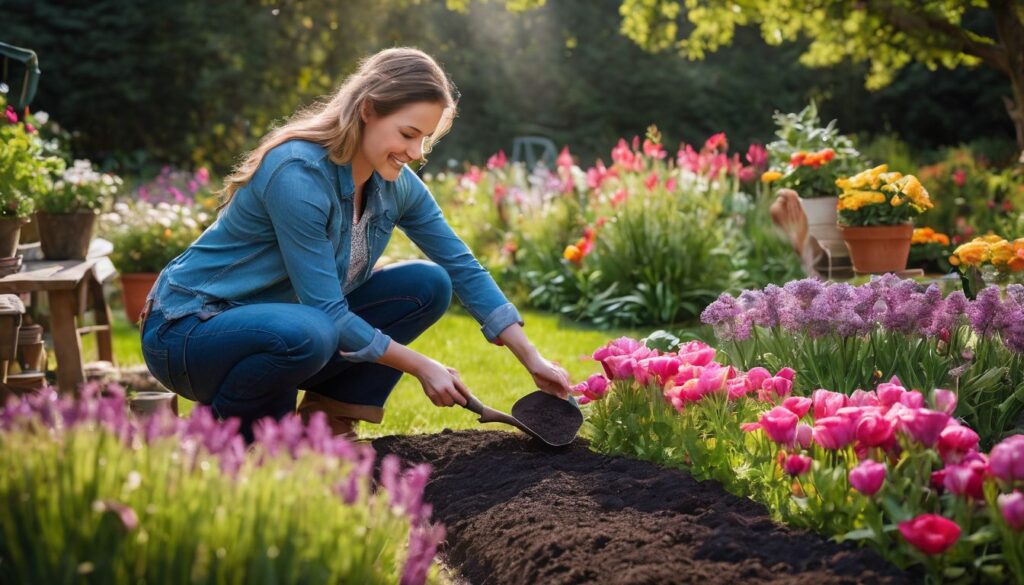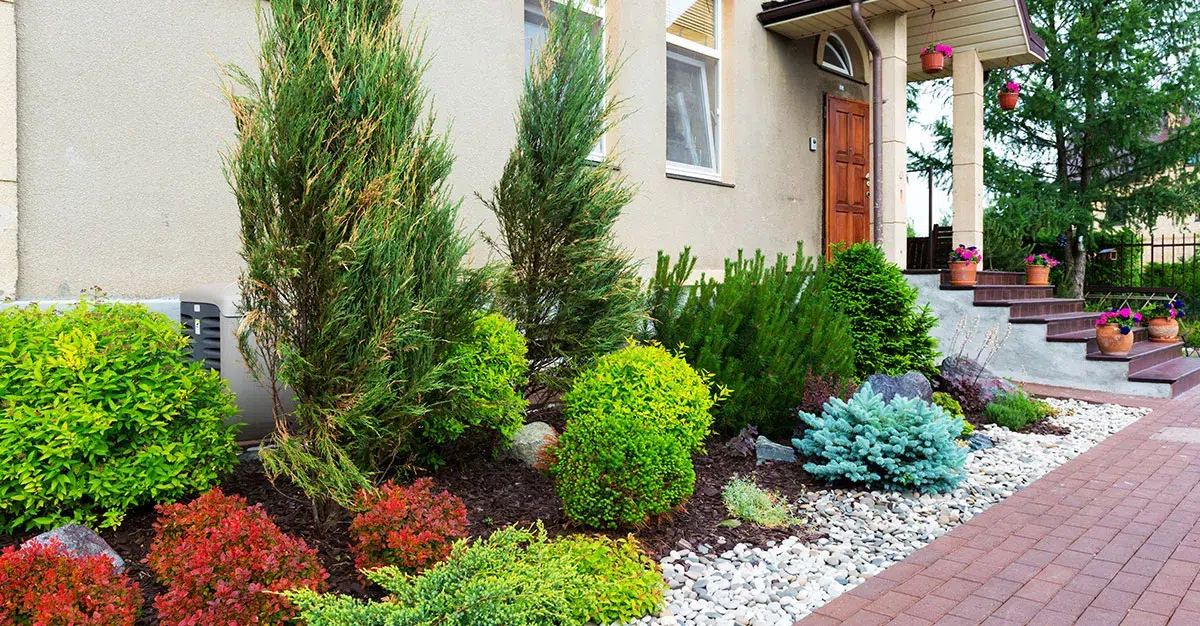As snow melts and the sun begins to shine brighter, you might notice your garden looking a bit sad after the long winter. Leaves scattered everywhere, plants that didn’t survive the cold, and a lawn in desperate need of attention for a new landscape design.
It’s common to feel overwhelmed by the task of bringing life back to your yard as spring arrives.
One important fact is that raking leaves and removing debris are crucial first steps in refreshing your landscape for spring. This article will guide you through reviving your landscape design from its winter slumber.
From clearing up debris to adding vibrant blooms, we’ve got tips and tricks to help. Get ready for a yard transformation that’ll make your neighbors green with envy!
Key Takeaways
- Begin refreshing your landscape by clearing debris, raking leaves, and removing dead plants to tidy up and prevent pests.
- Pruning is crucial for the health of trees and shrubs; trim dead or damaged branches to promote new growth and improve air circulation.
- Add vibrant color and texture to your garden by planting a mix of seasonal flowers like tulips, daffodils, and perennials such as daylilies. This creates an attractive outdoor space that attracts pollinators.
- Consider updates to hardscaping features like patios or pathways, repairing any winter damage for longevity. Adding new features like water elements can create inviting focal points.
- Incorporate functional outdoor living spaces with comfortable seating areas or fire pits to enhance enjoyment of your refreshed landscape throughout spring.
Basics of Landscape Design

Landscape design involves blending art and science for a balanced approach. Designers bring specialized training and experience to create aesthetically pleasing outdoor spaces.
Understanding design scope
Understanding the design scope means knowing how big or small your landscape project will be. It’s about deciding what parts of your yard need a makeover, from reviving turf to refreshing garden beds.
You’ll consider which areas require raking leaves and debris, crucial steps after winter has left its mark. This phase sets the stage for everything that follows, guiding choices for plants, hardscaping elements, and seasonal decorations.
You also decide on activities like soil preparation and pest control during this initial phase. Decisions on pruning dead branches and adding new flowers or shrubs are made with the overall vision in mind.
Knowing the scope helps you focus efforts where they’re needed most: whether it’s clearing winter debris to make way for fresh greenery or planning major additions that transform your outdoor space.
Approaching design with art and science
Landscape design combines artistic creativity and scientific knowledge to create outdoor spaces that are both visually appealing and functional. Balancing natural elements with human needs requires a deep understanding of horticulture, soil science, and environmental factors.
Designers use their training and experience to harmonize colors, textures, and proportions while considering practical aspects such as drainage, irrigation, and plant health.
For successful landscape design after winter, it’s essential to approach the process with an eye for aesthetics and a mind for practicality. The artistry lies in selecting seasonal flowers that add vibrant pops of color while the science involves choosing plants that thrive in your specific climate.
Training and experience
When it comes to refreshing your landscape after winter, it’s important to seek out professionals with the necessary training and experience. Knowledge of plant care, soil preparation, and pest control are essential skills for reviving your garden after the cold months.
With the right expertise in seasonal landscaping and horticulture, you can trust that your outdoor space will be rejuvenated effectively.
Choosing a team with proven experience in yard cleanup and seasonal garden maintenance ensures that your outdoor space is restored beautifully. Look for professionals adept at patio refurbishment or lawn restoration to breathe new life into your landscape design.
Importance of gardening in landscape design
After identifying the scope and approach of landscape design, it’s essential to recognize the importance of gardening in this process. Gardening plays a crucial role in creating an aesthetically pleasing outdoor space that complements your home.
Planting new flowers, shrubs, and trees not only adds color and texture to your landscape but also contributes to its overall health and vitality. Proper soil preparation, plant care, and pest control are practical steps for reviving your garden after winter.
Remember that incorporating seasonal flowers into your design can bring vibrancy and life back into your outdoor space.
Landscape Design Process
Evaluate your outdoor space, identify needs, and create functional diagrams to bring your landscape vision to life. Ready for a spring transformation? Read on to learn more!
Site inventory and analysis
Survey your garden and take note of any damage caused by winter weather. Observe the condition of soil, plants, trees, and hardscaping elements. Consider the need for soil preparation, as well as pest control measures to ensure a healthy outdoor space.
Look for areas with debris or dead plants that need clearing before planning new additions. Check for signs of weed growth and take note of which parts of the yard may require extra attention when refreshing your landscape design after winter.
Assess the health and vitality of your lawn by looking for patches that might need overseeding or aeration to support its recovery from winter dormancy. Take stock of existing plantings and identify areas where seasonal flowers could be incorporated to add bursts of color and texture to your landscape.
Determining needs
To determine your landscape design needs after winter, evaluate the condition of your garden and outdoor space. Assess if any plants have suffered damage from harsh weather or pests and prioritize their care.
Identify areas that need refreshing or updating, such as outdated features or worn-out hardscaping elements. Consider the functionality of your outdoor living spaces and whether they meet your current lifestyle needs.
Additionally, take stock of the soil quality to ensure it can support healthy plant growth in the upcoming season.
After a long winter, it’s essential to survey your landscape’s needs from various angles. This includes examining potential new additions for visual interest, such as colorful flowers or vibrant shrubs that enhance the overall aesthetic appeal.
Creating functional diagrams
When refreshing your landscape after winter, creating functional diagrams is essential for planning the layout of your outdoor space. This includes mapping out areas for new plantings, walkways, seating areas, and any other features you wish to incorporate into your design.
By visualizing these elements on paper or digitally, you can ensure that they work harmoniously within the space and meet your aesthetic and practical needs.
Choosing plants and features will be easier when creating functional diagrams as it allows you to see how different elements fit together in your landscape. Moreover, it provides a clear roadmap for carrying out the necessary maintenance tasks such as pruning and weeding throughout the spring season.
Choosing plants and features
Consider planting colorful annuals such as petunias, marigolds, and impatiens to add vibrancy to your landscape. Integrate perennials like daylilies, hostas, and coneflowers for long-lasting beauty year after year.
Incorporate features like birdbaths or decorative rocks to enhance visual interest and attract wildlife. Additionally, consider adding functional elements such as a water feature or outdoor seating area to create an inviting space for relaxation and enjoyment during the spring months.
Prepare your yard by clearing away debris and dead plants before introducing new additions. Prune existing vegetation for healthy growth while planning for new plantings that complement the existing landscape.
Refreshing Your Landscape After Winter
Revitalize your outdoor space by removing debris and dead plants, pruning and trimming overgrown branches, and planning for new additions to breathe new life into your landscape after winter.
Prepare your garden for a spring awakening by clearing the remnants of winter and setting the stage for a vibrant season ahead.
Removing debris and dead plants
Clearing away debris and dead plants is essential for preparing your landscape for spring. Raking leaves and removing any fallen branches will tidy up the space, preventing pests and diseases from spreading.
Additionally, pruning dead or damaged branches from trees and shrubs not only improves their appearance but also promotes their overall health. By eliminating weeds from garden beds and walkways, you can maintain a clean and manicured appearance in your outdoor space.
Choosing to plant new flowers, shrubs, or trees will breathe life back into your landscape after the winter months. This addition of color and texture can revitalize your outdoor space as it transitions into the rejuvenating season of spring.
Pruning and trimming
After removing debris and dead plants, the next step in refreshing your landscape design after winter is pruning and trimming. Pruning dead or damaged branches from trees and shrubs is crucial for the health and appearance of your plants.
It promotes new growth, improves air circulation, and reduces the risk of disease. Don’t forget to trim back any overgrown or unruly bushes to maintain a tidy and well-manicured look.
Incorporating these steps will ensure that your yard looks neat and healthy as it springs back to life.
Planning for new additions
Revive your garden after winter by planning for new additions. Select vibrant and hardy plants to inject color and life into your outdoor space. Choose seasonal flowers that thrive in the spring, such as tulips or daffodils, to create a visually appealing landscape.
Integrate new shrubs or trees to add depth and texture, enhancing the overall aesthetic of your garden. Consider adding outdoor living spaces like cozy seating areas or a fire pit to make your yard more inviting for relaxation or entertainment.
Prepare your turf for spring by considering overseeding and aerating techniques mentioned earlier. These methods can strengthen your lawn post-winter and make it more resilient against potential damage from foot traffic during warmer months.
Spring Landscape Design Ideas
Infuse your garden with the vibrant colors of seasonal flowers, adding a pop of freshness to your outdoor space. Ready for new ideas to breathe life into your landscape?
Incorporating seasonal flowers
Spring is the perfect time to infuse your landscape with a pop of color by incorporating seasonal flowers. Adding vibrant blooms like tulips, daffodils, and hyacinths can instantly breathe life into your outdoor space after winter’s dreariness.
These flowers not only provide visual appeal but also attract essential pollinators like bees and butterflies, contributing to a thriving ecosystem in your garden.
Incorporating seasonal flowers doesn’t just enhance the aesthetic of your landscape; it also signifies the arrival of spring and rejuvenation after the cold months. Introducing these vibrant additions alongside existing greenery can offer a refreshing contrast that uplifts your entire outdoor environment.
Adding color and texture
Incorporating seasonal flowers can bring vibrant color and a fresh, lively feel to your landscape after the winter months. Planting flowering shrubs or creating flower beds with a variety of blooms will add bursts of color throughout your outdoor space.
In addition, consider adding texture by incorporating different types of foliage, such as ornamental grasses or plants with interesting leaf shapes and patterns. These elements not only provide visual interest but also create depth and dimension in your garden design.
You can further enhance the visual appeal of your landscape by introducing decorative outdoor elements such as colorful pots, sculptures, or garden art. These additions can serve as focal points while contributing to the overall aesthetic of your outdoor space.
Incorporating outdoor living spaces
Incorporating outdoor living spaces into your landscape design can elevate the functionality and appeal of your yard. Adding a patio, deck, or outdoor kitchen provides a designated area for entertaining guests and enjoying meals alfresco.
Enhance the ambiance with mood lighting, comfortable seating, and vibrant planters filled with seasonal flowers to create an inviting space for relaxation and social gatherings.
Adding water features such as fountains or ponds adds a soothing element to your outdoor living space while attracting birds and wildlife. Integrate pathways through the garden to connect different zones of your yard, creating an immersive experience when exploring your landscaped areas.
Updating hardscaping elements
Enhance your outdoor space by updating hardscaping elements such as pathways, patios, and retaining walls after the harsh winter months. Repair any cracks or damage to existing structures caused by freezing temperatures and snow accumulation.
Apply a fresh coat of sealer to protect and revitalize surfaces, ensuring longevity and durability for the upcoming season.
Consider adding new hardscape features like fire pits or water features to create focal points in your landscape design. Incorporate decorative stones, pavers, or decorative gravels to add texture and visual interest to walkways and other areas.
FAQs
- How do I start refreshing my landscape after winter?
Begin by cleaning up your yard, removing any debris or dead plants from winter. This is the first step in preparing your garden and turf for spring. - What can I do to revive my garden after it’s been through a cold winter?
Reviving your garden involves assessing which plants survived and which didn’t, adding new soil and nutrients, and planting new flowers or shrubs as part of spring landscape rejuvenation. - Is there special care needed for my lawn in the spring?
Yes, spring lawn care includes aerating the soil, seeding bare spots, and applying fertilizer to prepare your turf for healthy growth throughout the season. - Can refreshing my landscape design really make a difference in how my outdoor space looks?
Absolutely! Refreshing your landscape design can transform your outdoor space by incorporating new plant varieties, updating garden layouts, and even undertaking an entire yard makeover for a fresh look. - What are some key steps in reviving my outdoor space during spring?
Key steps include performing a thorough yard cleanup after winter, planning out any desired changes to your garden beds or landscaping elements, revitalizing your lawn with proper care techniques like mowing at the right height and watering effectively—all contributing towards a successful spring garden revival.
Conclusion
Get ready to breathe new life into your outdoor space as spring approaches. Don’t overlook the essential tasks of raking debris, pruning dead branches, and removing weeds. Add a pop of color to your landscape design with fresh flowers and plants.
Revitalize your lawn with aeration and overseeding for a healthy green look. Prepare for the upcoming season by giving your yard the attention it needs after winter’s dormancy.

